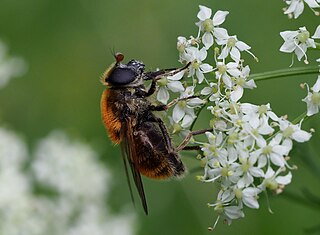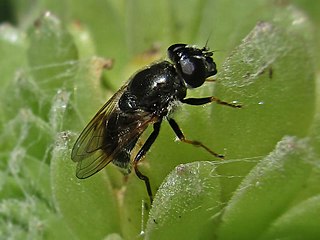
Merodon is a large genus of bee-like hoverflies. The majority of the species are centered on the Mediterranean and it is the second largest hoverfly genus in Europe with more than 50 European species. It is distributed over the Palaearctic and Afrotropical realms, with most European species occurring in Southern and Eastern Europe. The centre of distribution of this genus appears to be Turkey, where about 65 species have been recorded. Some species occur in Africa and the middle East, as far as Pakistan. Given the rate at which new species have been recorded over the past decades, the worldwide number of species could exceed 200. The larvae feed on the bulbs or rhizomes of monocotyledons.

Criorhina berberina is a species of hoverfly. It is found in the Palaearctic from Fennoscandia South to Iberia and Italy. Ireland eastwards through Europe into Turkey and European Russia . C. berberina is a bumblebee mimic. The body has uniformly long dense pubescence, obscuring the ground-colour. There are two forms one with the pubescence more or less extensively blackish, one in which it is entirely yellow or tawny. Criorhina differ from other bumblebee mimics - Mallota, Arctophila, Pocota and Brachypalpus by the form of their antennae: the first segments are thin and form a stalk, the third segment is shorter than it is wide. In Criorhina, the face projects downwards, in contrast to Pocota and Brachypalpus.

Neoascia is a genus of small black and yellow or mostly black flies with a narrow abdomen near the thorax. They occur mainly in damp places among low herbage. The larva of Neosascia are flattened without oral hooks and a have a short posterior spiracular process or "tail" rat-tailed that is saprophagous. In 1925 Curran reviewed the genus Neoascia. In this work a key is provided and ten species are described including four new species some of which have later been determined to be synonyms.

Neoascia podagrica is a species of hoverfly.
Chamaesyrphus is a genus hoverflies, from the family Syrphidae, in the order Diptera. Small yellow and black flies. Antennae with segment 3 large and almost evenly rounded, the arista only slightly thickened towards base and inserted before the actual anterior dorsal tip of the segment. In contrast to Pelecocera.

Heringia or the Smoothleg fly is a genus of hoverflies, from the family Syrphidae, in the order Diptera. The species are distributed in North America and Europe Larvae are predatory upon Schizoneura aphids on Ulmus and Pemphigus aphids on Populus, Dreyjusia piceae on Abies and Eriosoma lanigerum on Malus.

Pipiza is a genus Hoverflies, from the family Syrphidae, in the order Diptera. Most are dark hoverflies.

Pipiza bimaculata is a species of hoverfly, from the family Syrphidae, in the order Diptera.

Trichopsomyia flavitarsis is a European species of hoverfly.

Paragus haemorrhous,the Black-backed Grass Skimmer is a common widespread species of hoverfly found in many parts of Europe, Africa and the Nearctic. Hoverflies can remain nearly motionless in flight. The adults are also known as flower flies for they are commonly found on flowers from which they get both energy-giving nectar and protein-rich pollen. The larvae are predators on aphids.

Neoascia meticulosa is a species of hoverfly.

Pelecocera tricincta is a species of hoverfly, from the family Syrphidae.

Cheilosia antiqua is a European species of hoverfly.

Cheilosia chrysocoma is a European species of hoverfly.

Neoascia tenur is a Palearctic species of hoverfly.

Xylota abiens is a European species of hoverfly.

Chrysogaster cemiteriorum is a European species of hoverfly which can be found feeding on umbelliferous flowers wetlands and damp meadows.
Neoascia geniculata is a Palearctic species of hoverfly.

Cheilosia caerulescens is a Palearctic hoverfly.

The Spheginina is a subtribe of hoverflies.

















